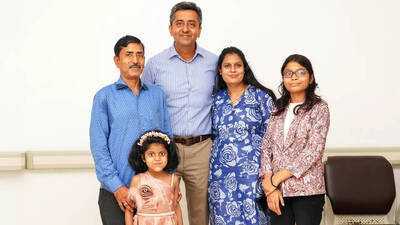 Dr Somnath Chattopadhyay
Dr Somnath Chattopadhyay
When little Kavya came to us, she was just five years old but already carrying the heavy burden of a rare liver disease called Biliary Atresia . It’s a condition in which the bile ducts inside the liver are either blocked or missing, so bile cannot drain properly. This causes the liver to get damaged and scarred over time. Sadly, without a transplant, the damage is often fatal.
Kavya’s story was especially close to my heart because her elder sister, Dhruvi, had battled a similar illness a decade ago. Dhruvi was four when we placed a part of her mother’s liver in her tiny abdomen. She recovered successfully and was now a sprightly teen. Seeing that family’s journey — the hope, struggles, the triumphs — was deeply moving. So, when Kavya needed a transplant, we knew we were fighting not just for her life but carrying forward a shared hope.
Usually, when a child needs a liver transplant , one of the parents donates a part of their liver. It’s a complex but common practice because blood group compatibility is simpler, and the parents are naturally the first choice. But in Kavya’s case, it wasn’t that simple. Her mother had already donated for Dhruvi, and her father wasn’t eligible because he had fatty liver disease. It was then that her 70-year-old grandfather stepped in without hesitation.
Now, here’s where the challenge really began. Kavya’s blood group was A positive, while her grandfather’s was B positive — a mismatch that would typically make transplantation nearly impossible. To complicate matters further, Kavya’s immune system had already developed antibodies against her grandfather’s blood type. These antibodies are like tiny soldiers that recognise and attack anything foreign, including the donated liver. This mismatch and the existing antibodies could have led to immediate rejection of the transplant, risking Kavya’s life.
But we found a crucial piece of hope. When we measured the levels of these antibodies in Kavya’s blood, they weren’t as high as we had feared. This meant there was a real chance to control her immune system enough to accept the new liver.
Our plan was twofold. First, we gave Kavya a medicine called Rituximab . It sounds complicated, but Rituximab works by calming down the immune cells that make those harmful antibodies. Think of it as turning down the volume on the part of the immune system that would otherwise attack the transplant.
Second, we performed plasma exchange therapy. Imagine your blood as a river, with plasma as the liquid part that carries antibodies. Through plasma exchange, we ‘washed out’ the harmful antibodies by removing some of her plasma and replacing it with clean plasma. This process helps to clear away the soldiers ready to attack the new liver.
It was a delicate dance, and every step had to be perfectly timed and executed. We knew that if even a small number of these antibodies remained, Kavya’s body could reject the new liver immediately, which is often fatal.
Adding to the challenge, Kavya had undergone major surgery as an infant. This had left scar tissue inside her abdomen, making the transplant surgery more complicated and riskier. Our team used advanced imaging to carefully plan how the grandfather’s liver segment would fit inside Kavya’s small abdomen, ensuring it wouldn’t cause harm or pressure.
The family’s courage was remarkable throughout. Having already walked this path with their elder daughter, they understood what lay ahead. Yet, the financial strain was very real. The Jains are a modest family. Kavya’s mother reached out to NGOs for support. Our hospital’s trust also stepped in to help ease the burden somewhat.
As for her grandfather, he underwent a series of tests — blood work, scans, heart checks — to ensure he was healthy enough to donate part of his liver. Donating a piece of your liver is a major decision. It involves surgery, pain, recovery, and risk. We make sure donors understand everything clearly and often connect them with people who have donated before. But in the Jains’ case, their previous experience had prepared them emotionally and mentally.
On Feb 22, Kavya was admitted. Two weeks later, the big day arrived. For ten intense hours, two surgical teams worked, connecting the liver to her blood vessels and bile ducts with utmost precision. Watching Kavya recover after surgery was incredibly rewarding. She was discharged in three weeks. Her grandfather, too, recovered well and was back to work in just seven days.
Just a few decades ago, a transplant like this would have been unthinkable. Transplants across blood group barriers almost always ended in rejection. But advances in medicines like Rituximab and improved plasma exchange techniques have revolutionised what’s possible.
India has become a leader in living donor liver transplantation . This progress came from necessity — due to fewer deceased donors — but also from innovation, skill, and determination. Today, we perform more living donor liver transplants than any other country, often at a fraction of the cost seen in Western nations.
To families facing the frightening prospect of paediatric liver disease and transplantation, my message is simple: don’t lose hope. While it may feel overwhelming, these transplants have excellent success rates. Children go on to live full, vibrant lives — going to school, pursuing careers, building families.
And while the idea of transplantation can be scary, it’s safer today than ever before. Donors’ livers regenerate, making living donation a powerful and safe gift.
Dr Chattopadhyay is consultant and head of Hepato-Pancreato-Biliary Surgery and Liver Transplant at Kokilaben Dhirubhai Ambani Hospital, Mumbai. He spoke to Sharmila Ganesan Ram
 Dr Somnath Chattopadhyay
Dr Somnath Chattopadhyay